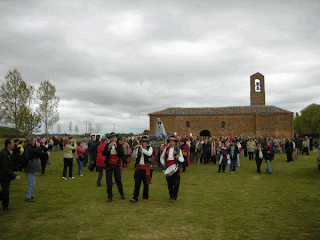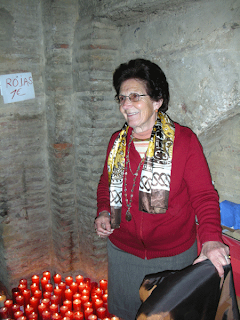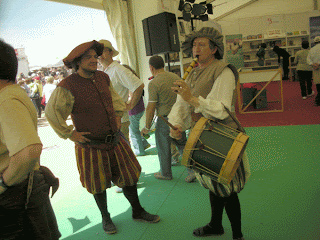
Well, we thought today would be a nice, quiet day—and it was, sort of. We relaxed, enjoyed the morning, and went out for a walk at high noon (2 pm) to the park alongside the river. We dozed in the sun, shivered in the cool breeze, watched the birds hunting for insects, listened to the weeping willows rustling. And then we started home.
We paused in front of an interesting looking arched doorway and a plaque: “Casona de San Benito.” What was that, we wondered? An old man was leaning on a cane, standing nearby. I (Elyn) walked over to the large door and peeked inside. I (Elyn) saw a courtyard, an archway, and beyond that open fields and blue sky.
The old man, who was watching the German tourists who had disembarked from a tour bus, motioned to us. We went over to him.
“Want to go in?” He asked in Spanish. (The following conversation was all in Spanish.)
We looked at each other. “We can go in?”
“Of course!”
So we walked over to the large doorway, which he pushed open, and in we went. We saw a large patio, with a woman watering flowers at one end and a man (her husband) working on something at the other. The old man (Leonora’s father, it turned out) explained he had invited two Germans to see the place. I (Elyn) explained that we were Americans and lived in Sahagún.
Leonora’s husband exclaimed, “Oh, you’re German’s friends!”
And Leonora exclaimed, “I met you during Semana Santa, remember?”
Ah. These were the friends German had told us about. He and Peggy had held their medieval wedding pageant last August in their home, the House of the Arch. This house. Small world.
We were taken on a tour of the place, including the immense banquet hall, still sporting medieval banners and 19th-century tapestries. This was probably the refrectory of the immensely powerful Cluny Benedictine monastery (hence the “San Benito” on the entry plaque) that had once controlled Sahagún. In the 19th century, during the desamortización, monastic lands and buildings were confiscated, often destroyed, and bought by anyone who had the money and interest. Leonora’s great-great-great grandfather (more or less) had bought the monastery (or what remained of it), along with a few other monastic buildings in Sahagún and a nearby town. Now, some 200 years later, the descendants used one wing as a sort of vacation home and were turning another wing into a tourist/pilgrim hostal.
The husband pointed out the long, narrow Mudejar bricks, from the 12th century, that made up the walls of the huge room. He said there were some Roman bricks mixed in, if we looked closely…. The ceiling was much newer—17th century.
And then, downstairs to the huerta (garden) that had been the monastery’s cloisters and gardens, several centuries ago. And on to other buildings and outbuildings, including the so-called Palace of Queen Constance, the second wife of Alfonso VI, the remains of which were now used as a garage, a storeroom, and a chicken and rabbit shed.
Just this morning we had read in the newspaper that 2009 is the 900th anniversary of the death of King Alfonso VI, who at one time was forced to retire as monarch of León and seek refuge in the Benedictine monastery of Sahagún. Later, after he regained power, he liked to return here, and he and most of his five wives (and various concubines) are buried here. Alfonso’s second wife, Constanza (from Burgundy), had had a special set of rooms built for her use in the monastery. Later those rooms became a place that gave hospitality to pilgrims….
So here we were, standing in the midst of 900-year-old history!
Amazing.
I could just see the marketing ploy for the new hospice: "Alfonso VI slept here."


















































